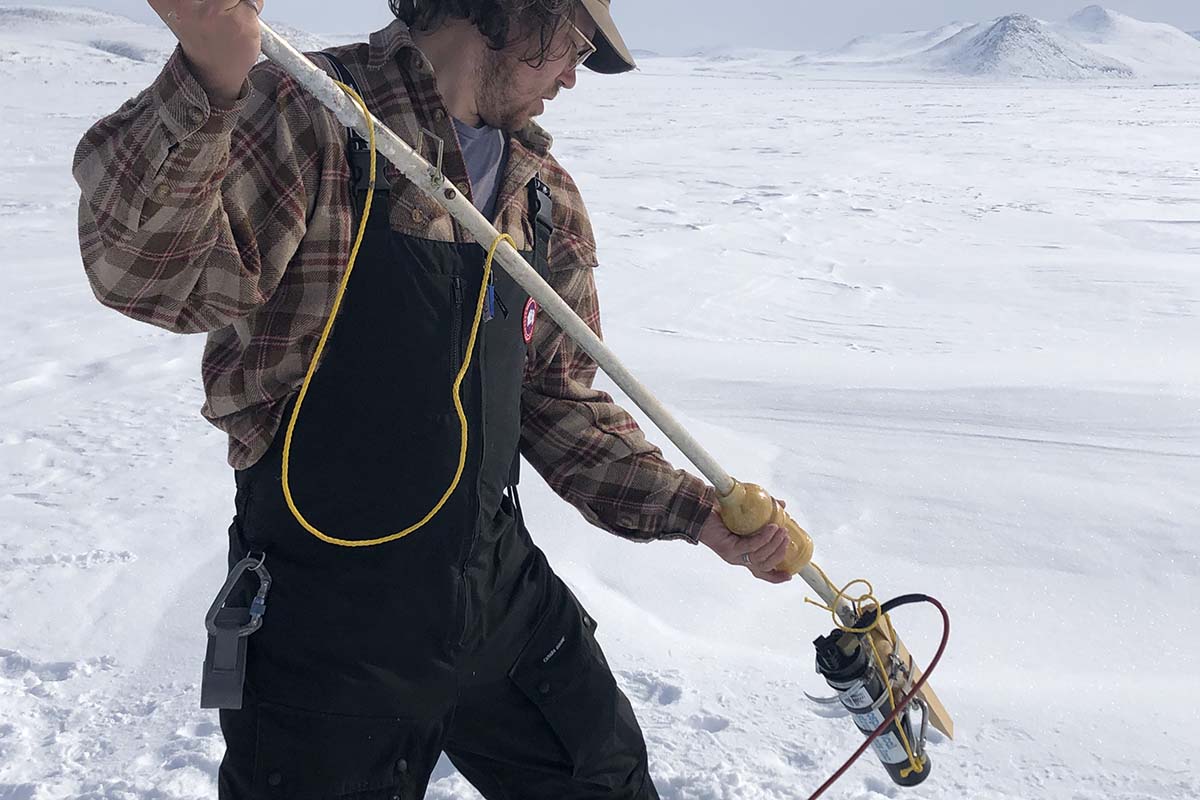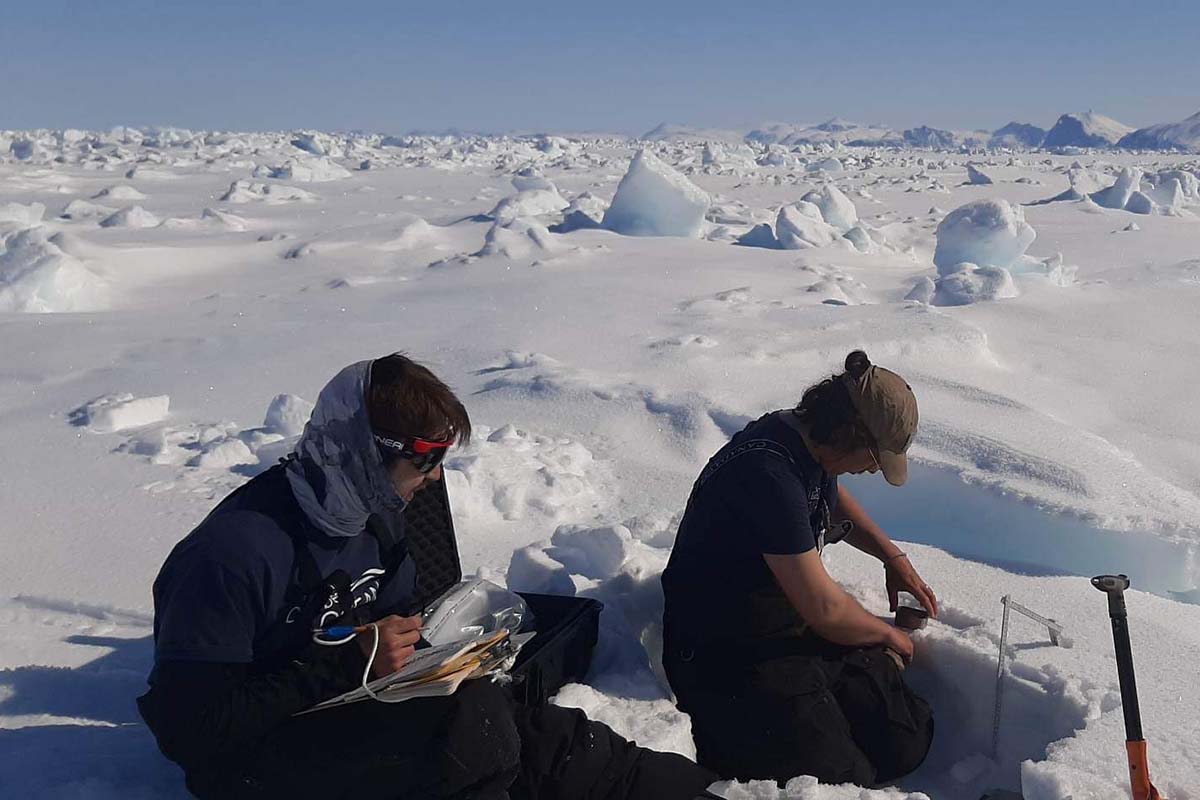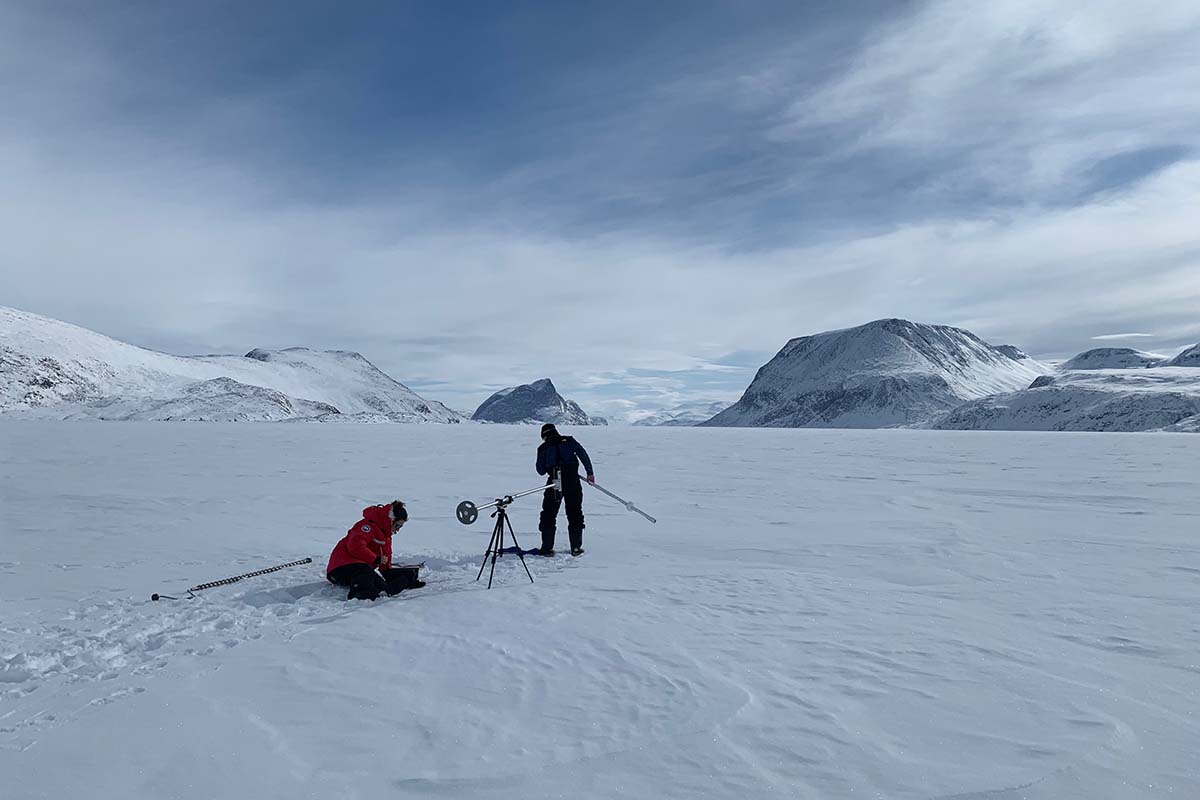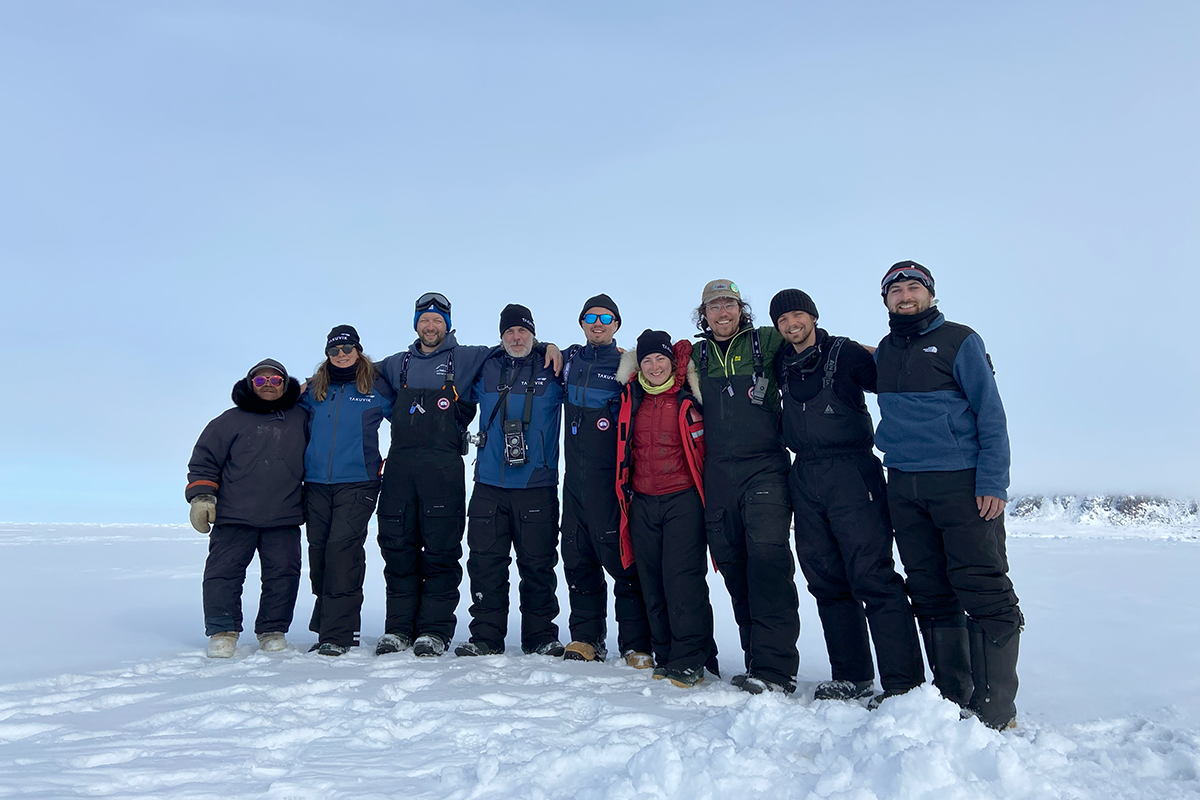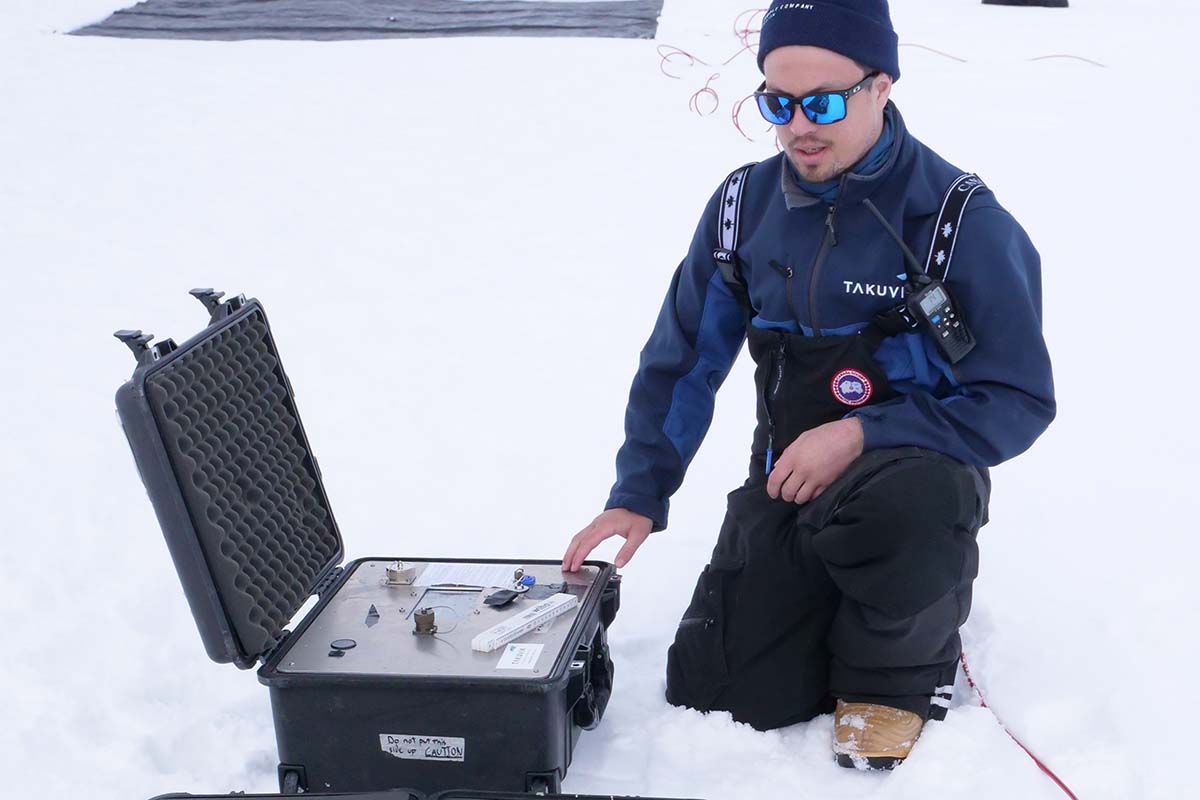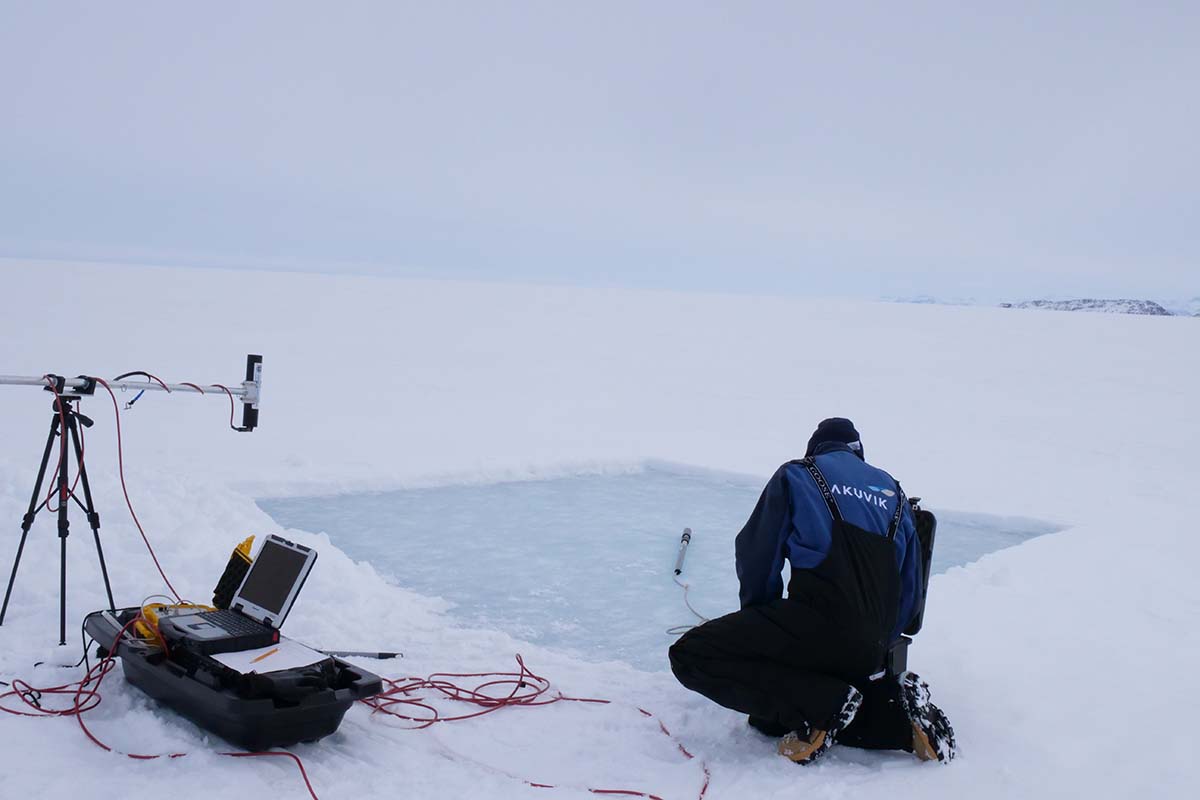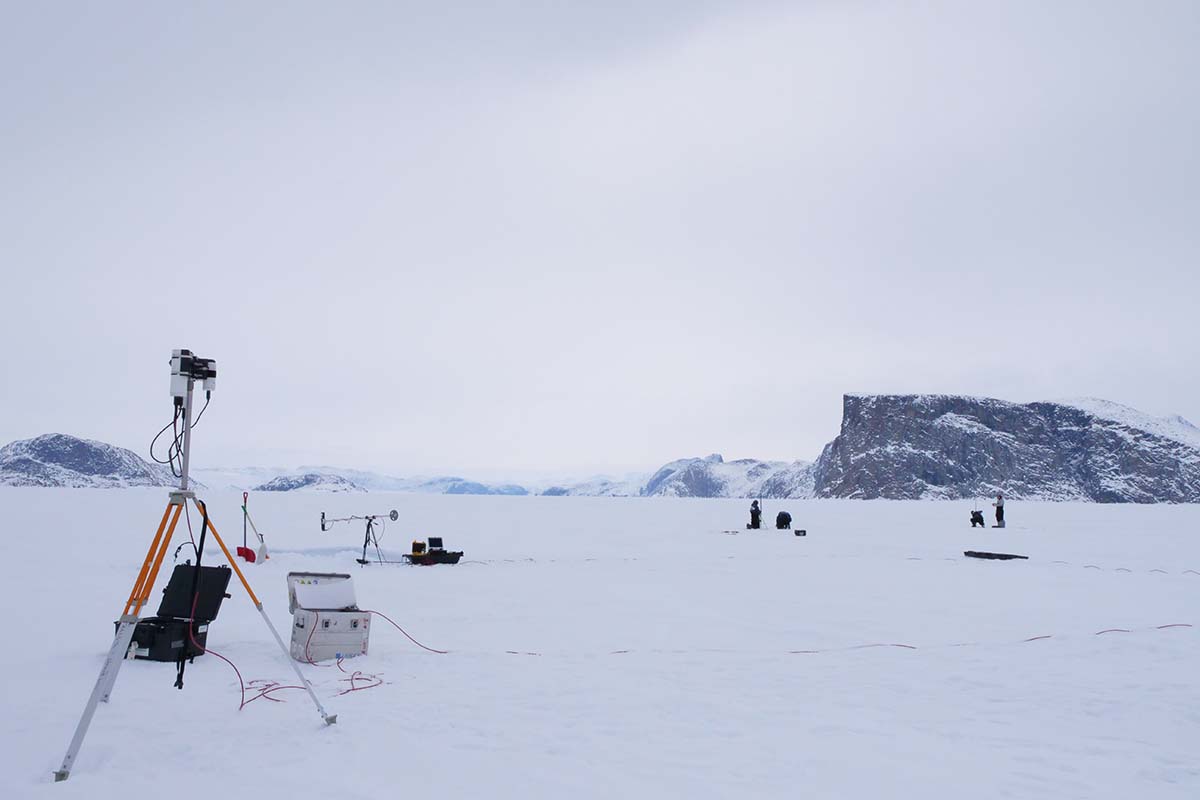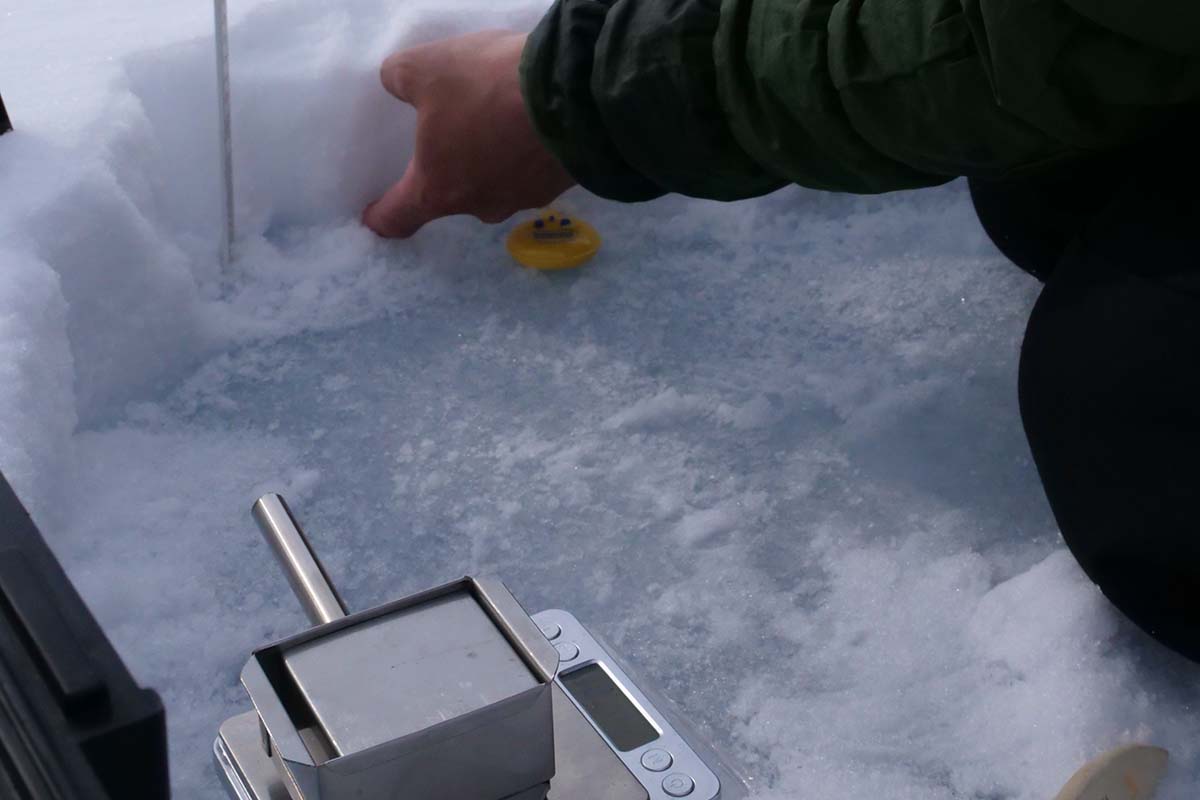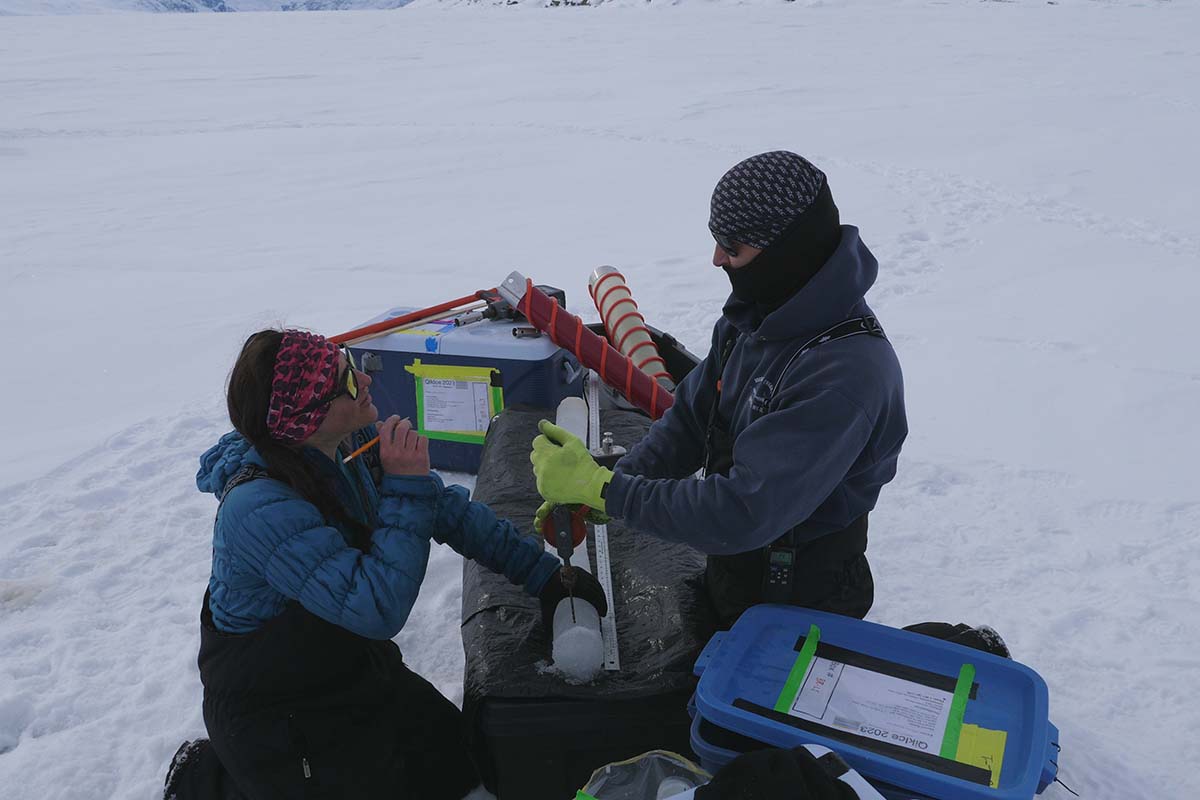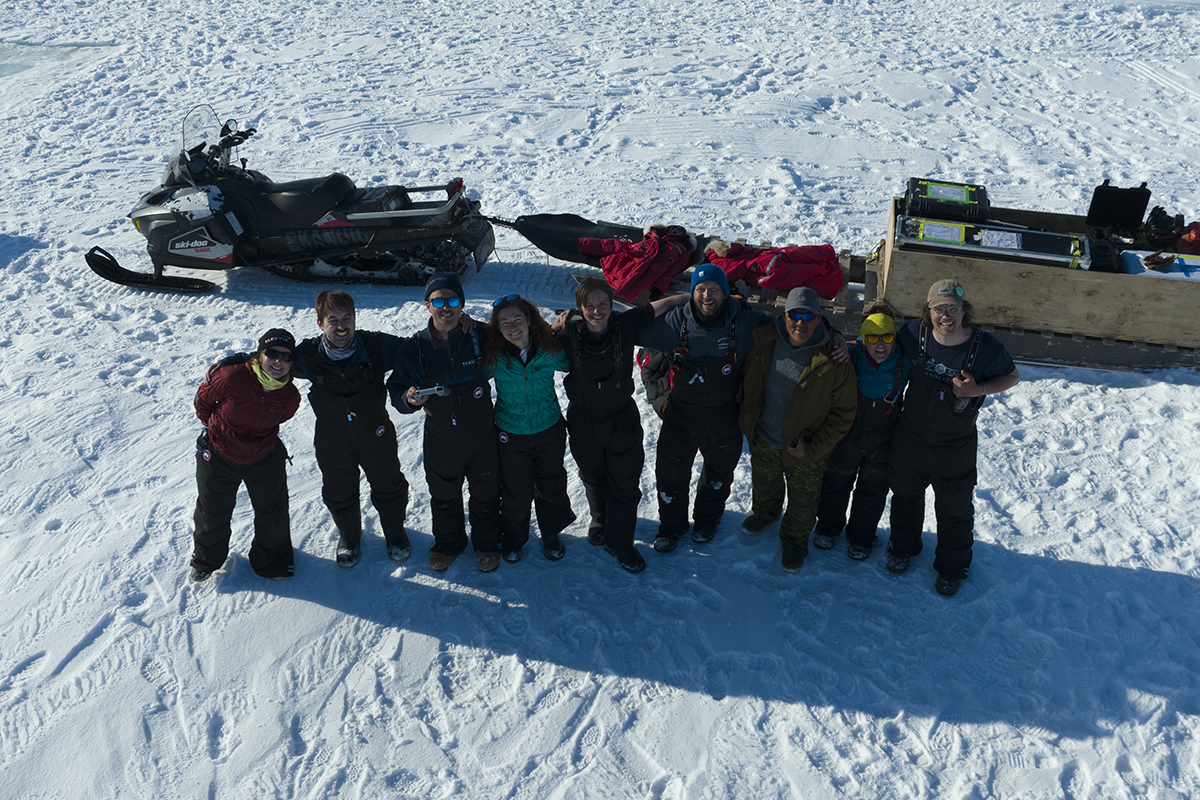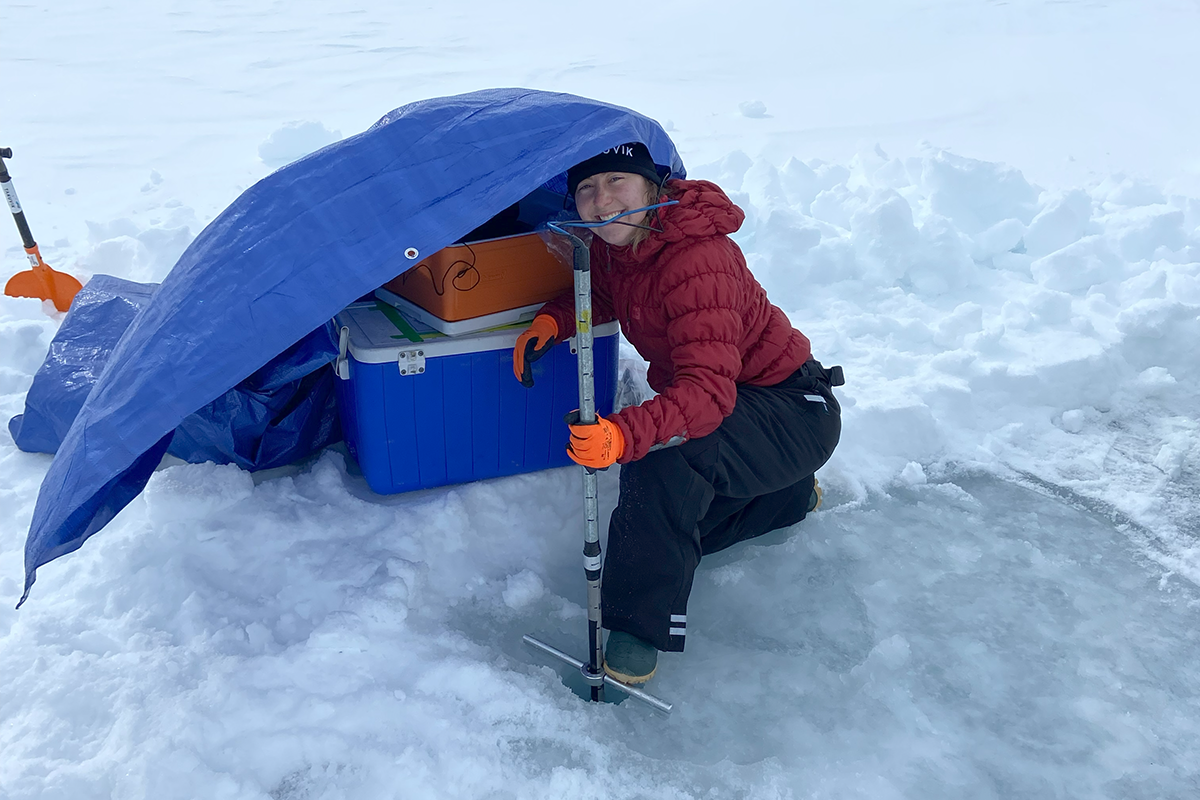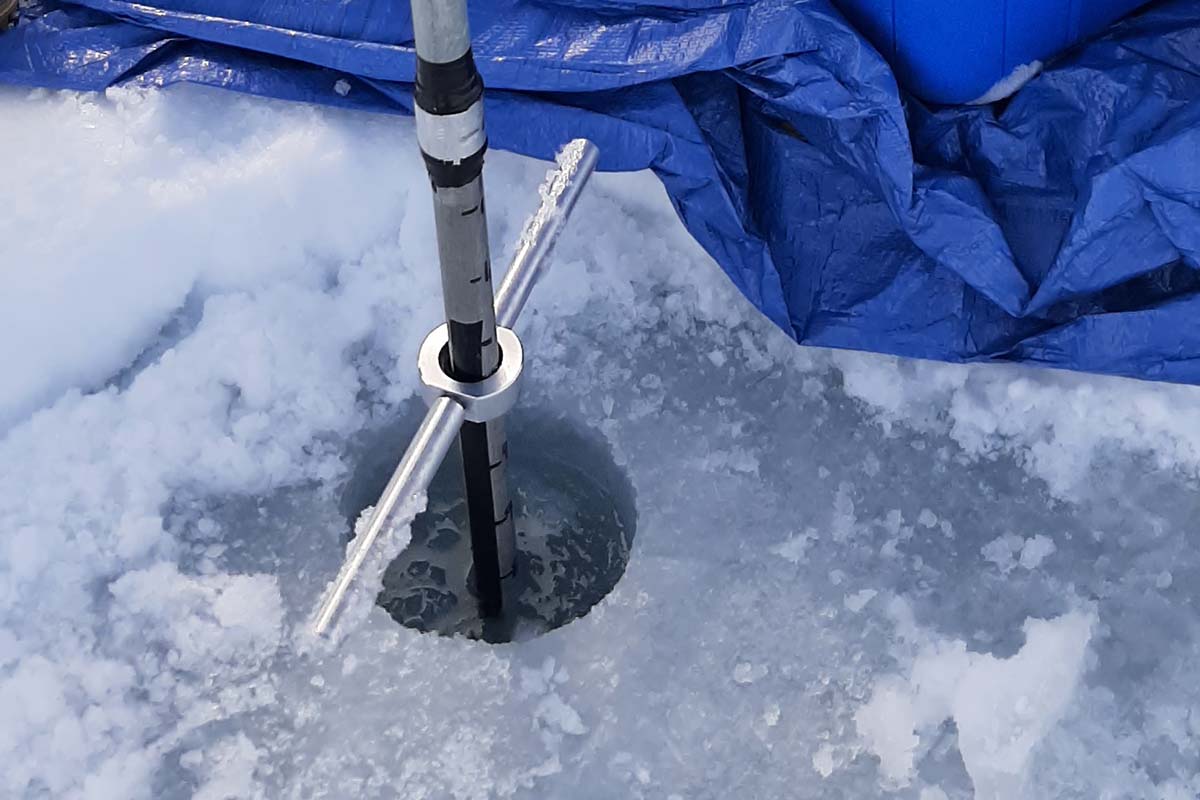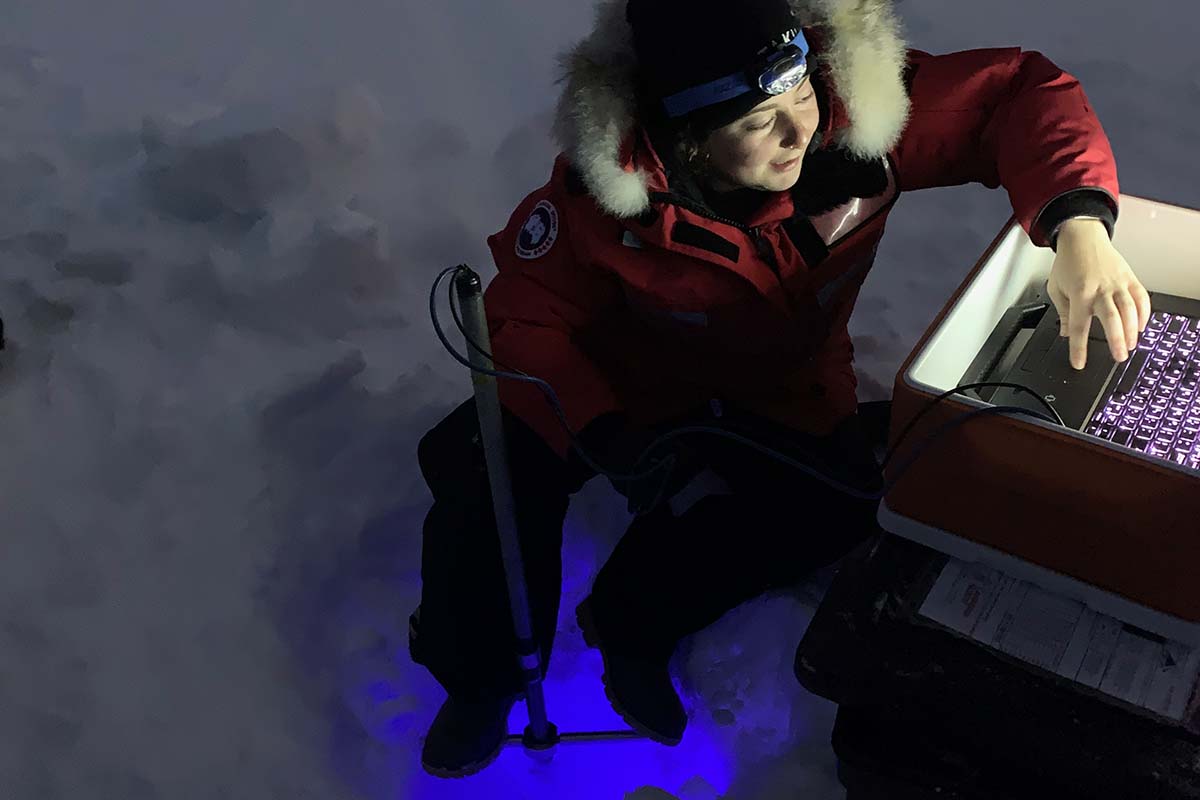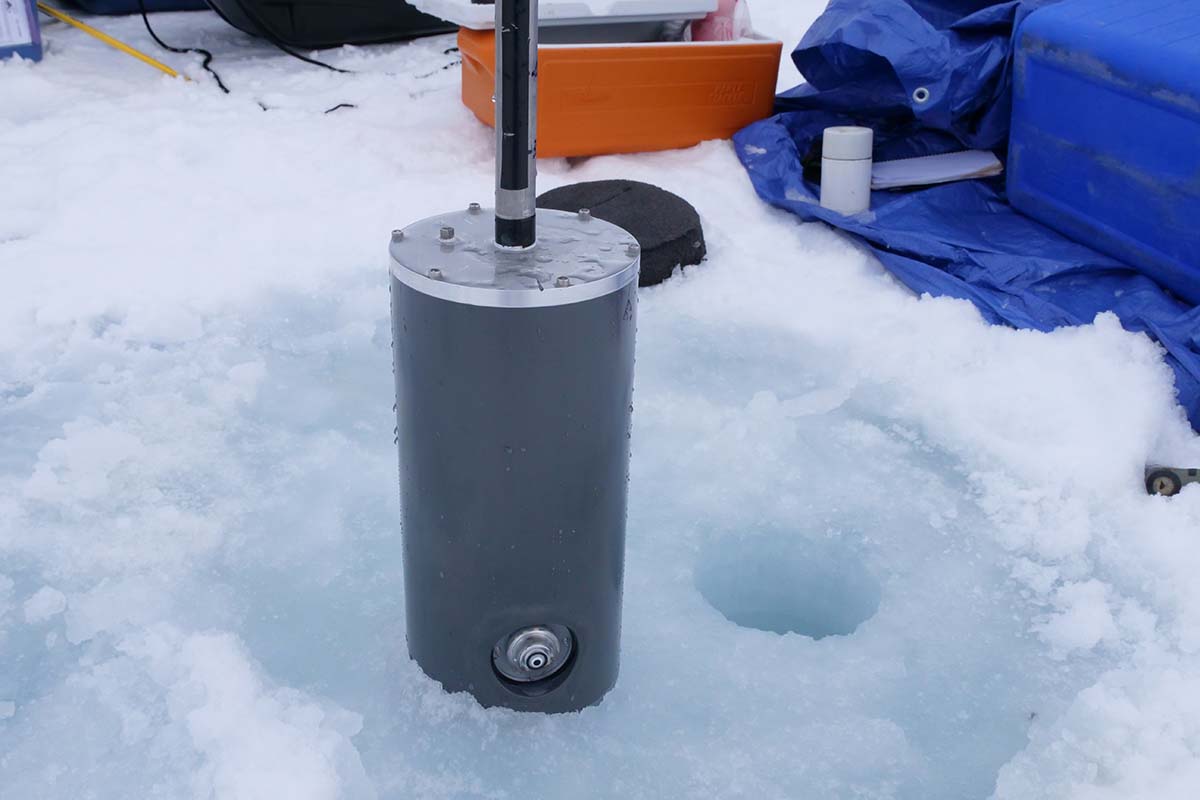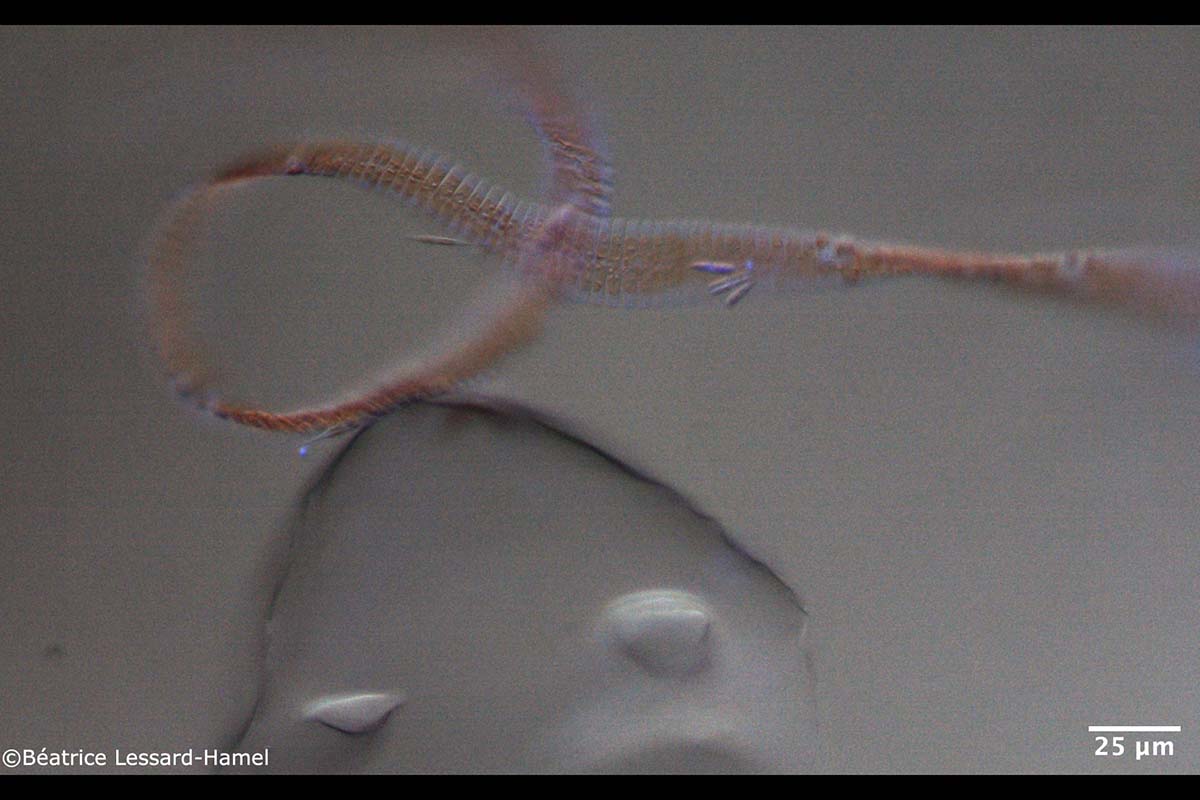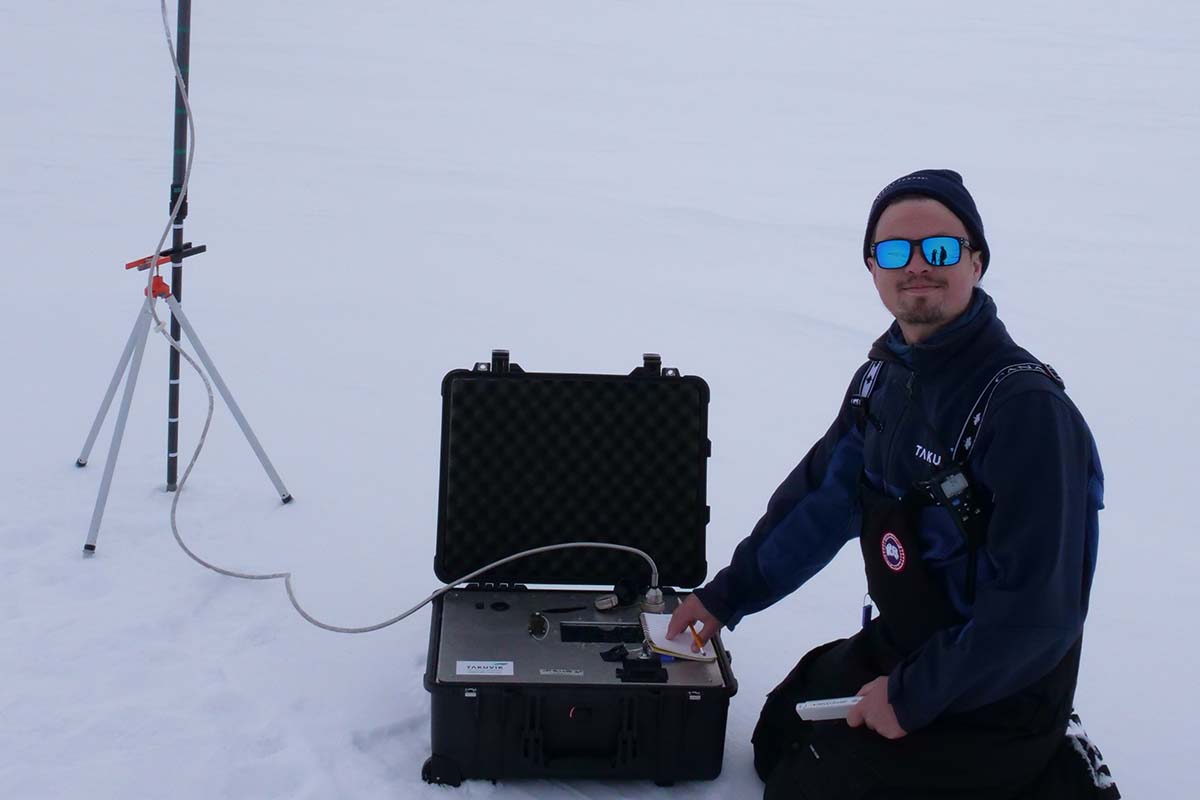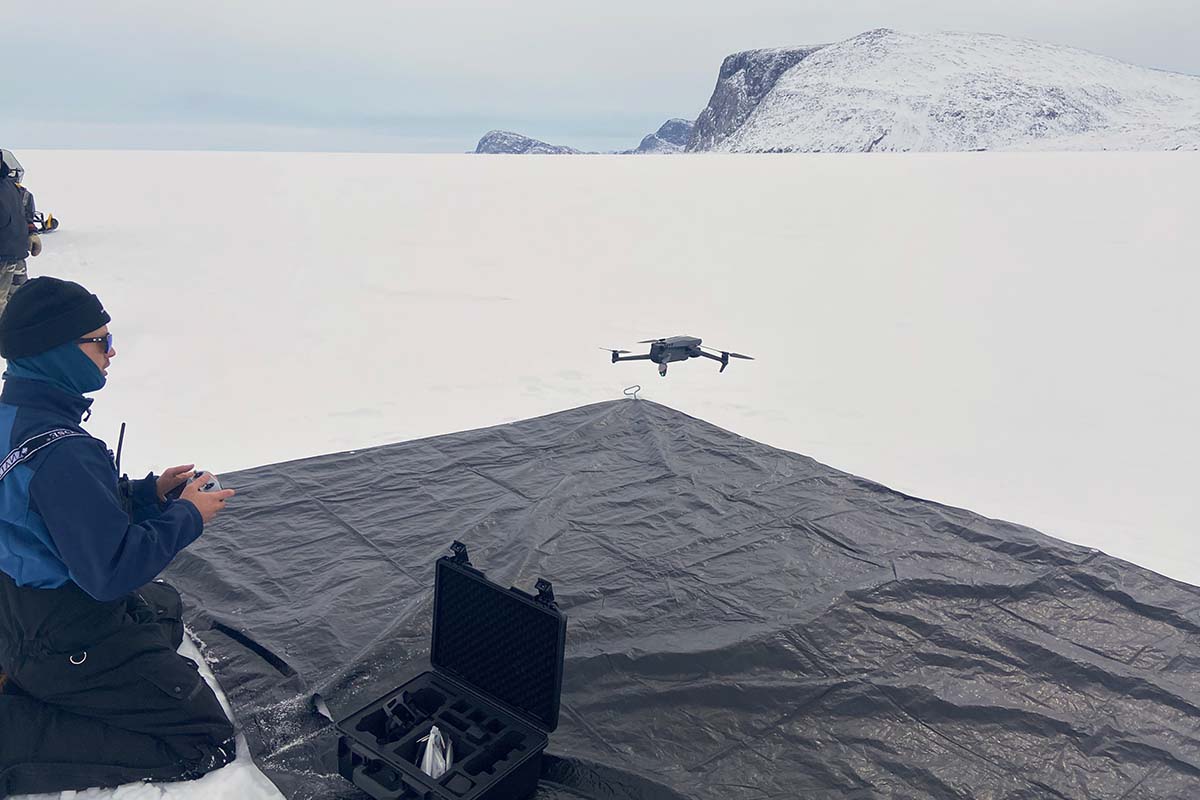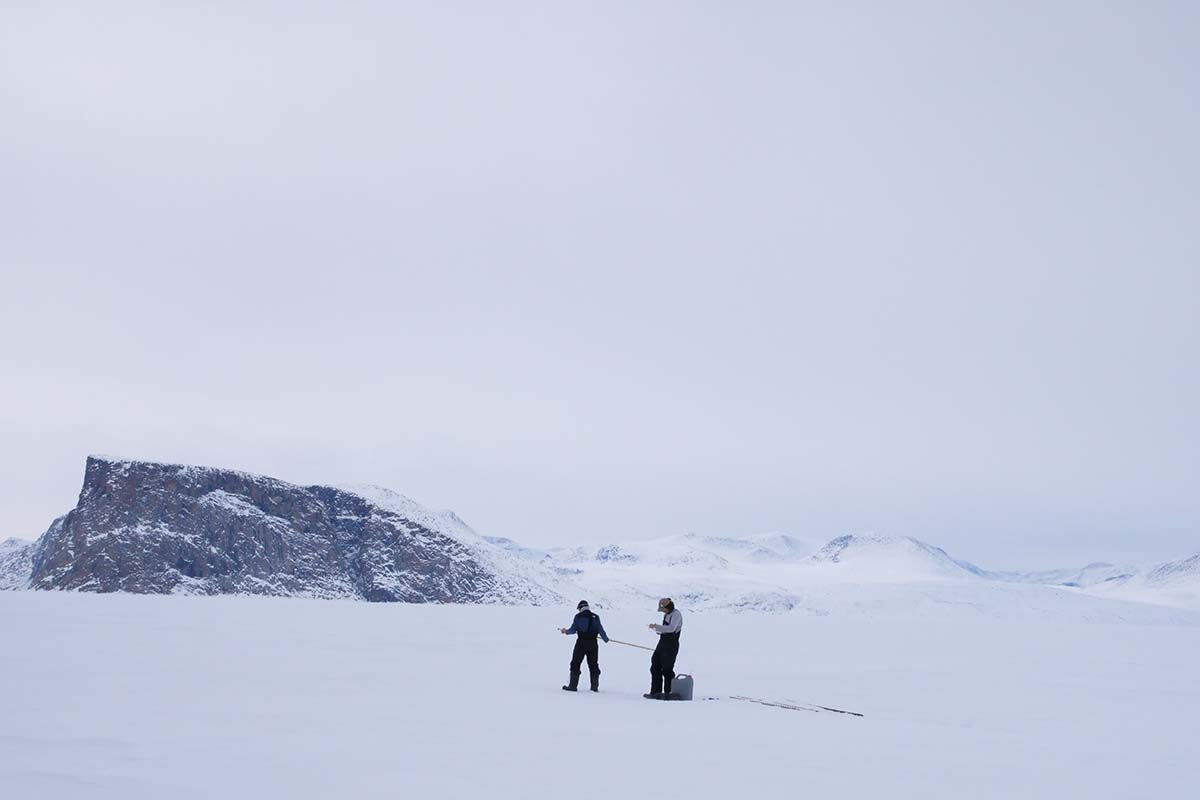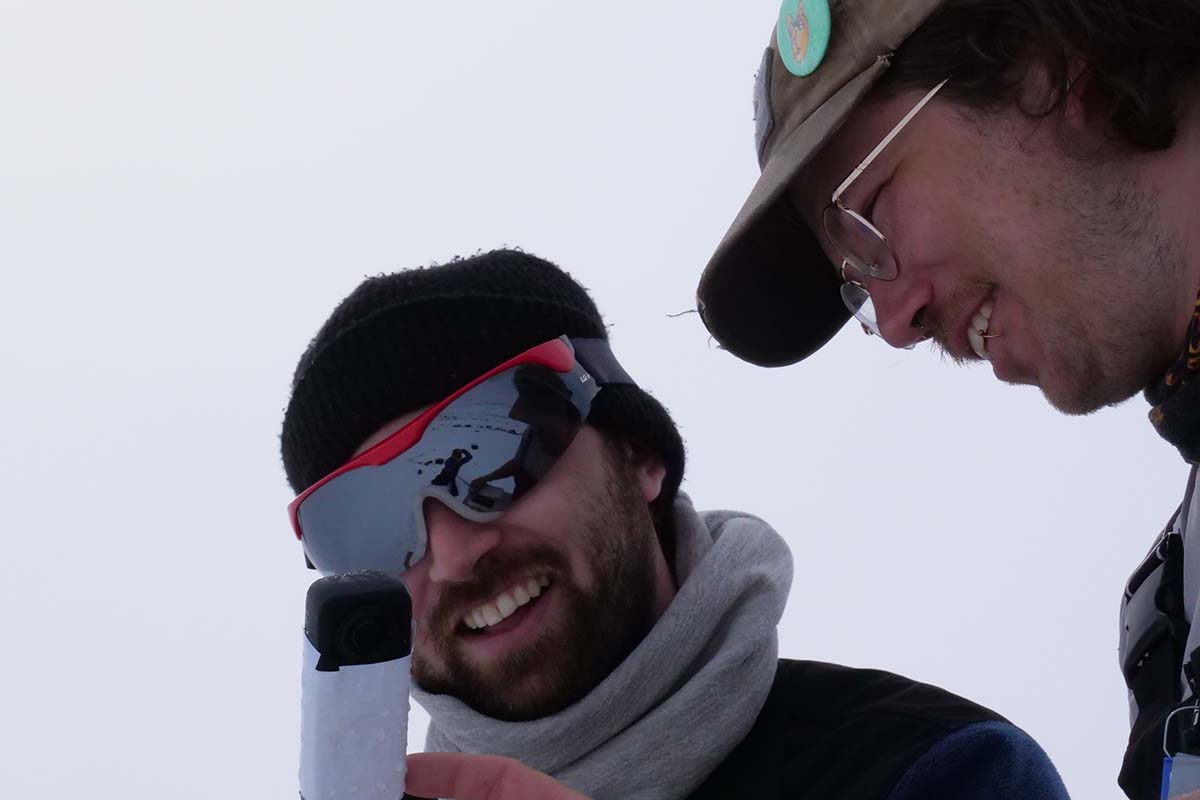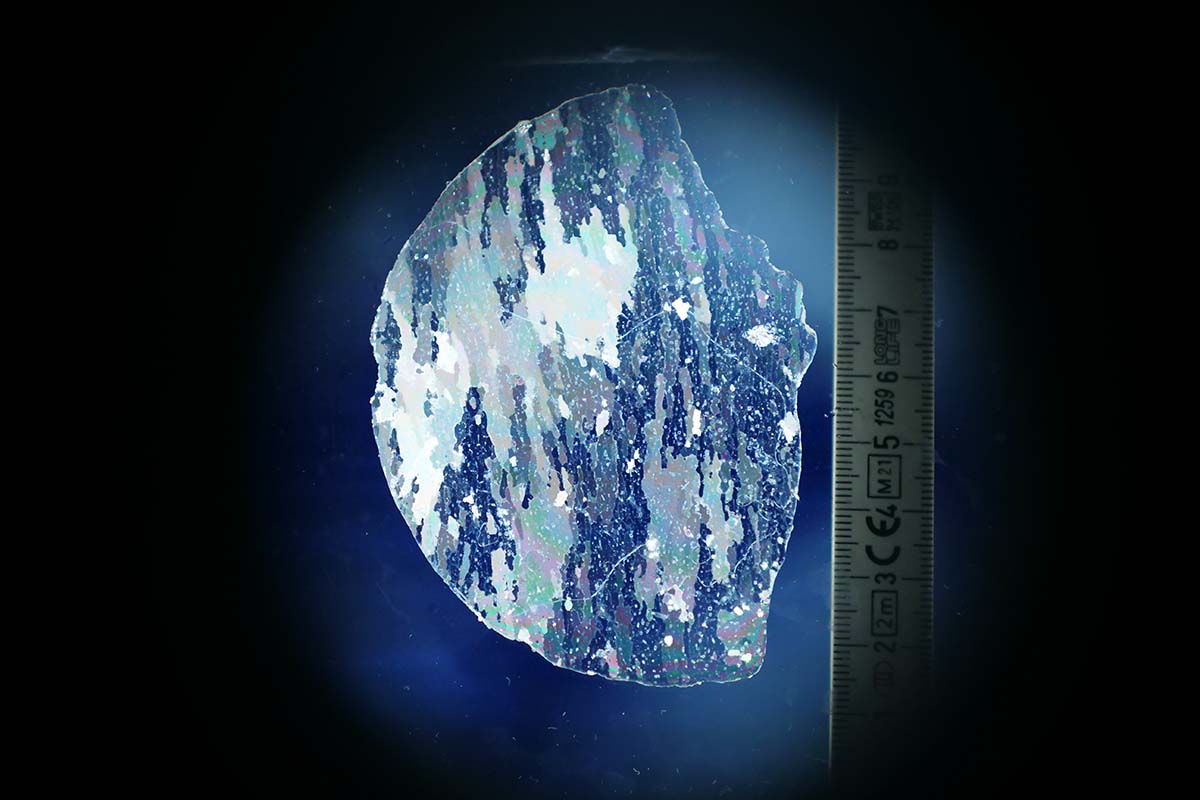QikIce 2023 : Towards an understanding of the light and ice interaction with novel sea-ice endoscopes
During the Arctic spring, the availability of light is the main limiting factor for the growth of in-ice, under-ice, and open water algae blooms. In winter, most of the sunlight gets backscattered by the snow to the atmosphere, giving the sparkling white color to the region. As spring approaches, the snow becomes thinner and moister, allowing more light to reach the underlying ice. While measuring the amount of light is relatively easy, understanding the radiative transfer process that occurs inside the ice is challenging.
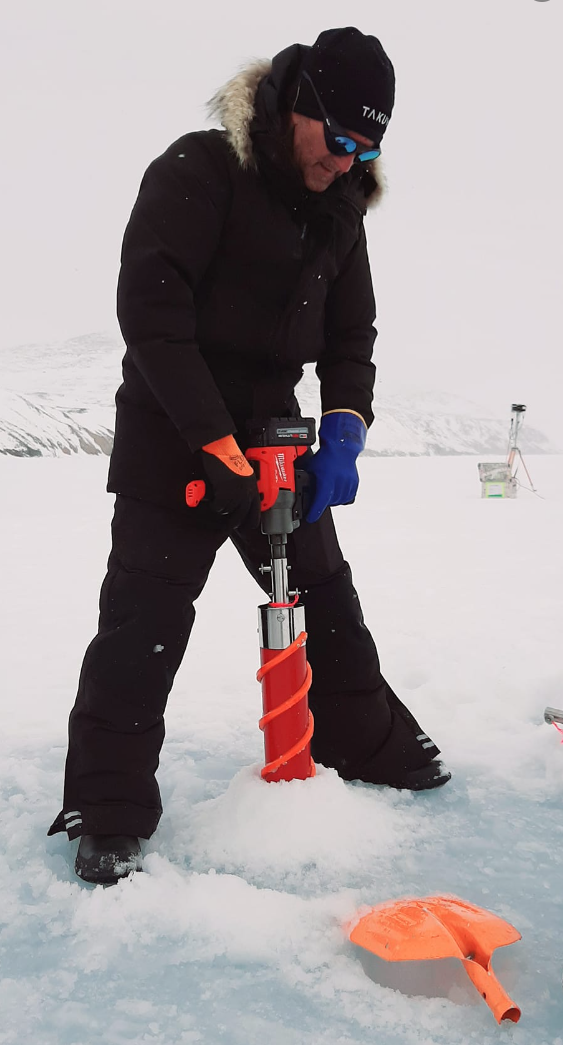 To address this challenge, the QikIce 2023 mission, which took place near Qikiqtarjuaq, Nunavut, from 19 April to 3 May and led by Marcel Babin, employed a combination of established and cutting-edge techniques. The Takuvik International Research Laboratory developed new endoscopic techniques that are less disruptive and allow in-situ measurements directly on the icepack. The mission had two focuses. The first focus was on the optical properties of the ice-snow pack. Classical radiometers were used to measure the reflectance and transmittance of the sea-ice pack (GB, RL, CP, BR). In addition, sea-ice endoscope techniques were developed to measure in-ice tridimensional photon fluxes using a calibrated 360 camera (RL, BR), and the scattering properties of the ice were measured using a diffuse reflectance probe (CP). Absorption coefficients were measured by filtering the contents of ice cores to observe their particulate and dissolved colored matter content (BR, MHF, JF, GB, BLH). The microstructure of the ice pack was also examined. Several snowpits were made to study the different layers of snow and the crystals composing them (BR). The crystallography of the ice was also studied by taking advantage of the natural birefringence of the sea ice (RL).
To address this challenge, the QikIce 2023 mission, which took place near Qikiqtarjuaq, Nunavut, from 19 April to 3 May and led by Marcel Babin, employed a combination of established and cutting-edge techniques. The Takuvik International Research Laboratory developed new endoscopic techniques that are less disruptive and allow in-situ measurements directly on the icepack. The mission had two focuses. The first focus was on the optical properties of the ice-snow pack. Classical radiometers were used to measure the reflectance and transmittance of the sea-ice pack (GB, RL, CP, BR). In addition, sea-ice endoscope techniques were developed to measure in-ice tridimensional photon fluxes using a calibrated 360 camera (RL, BR), and the scattering properties of the ice were measured using a diffuse reflectance probe (CP). Absorption coefficients were measured by filtering the contents of ice cores to observe their particulate and dissolved colored matter content (BR, MHF, JF, GB, BLH). The microstructure of the ice pack was also examined. Several snowpits were made to study the different layers of snow and the crystals composing them (BR). The crystallography of the ice was also studied by taking advantage of the natural birefringence of the sea ice (RL).
The second focus of the mission was on the life that can thrive in the brine channels. For the first time, an endoscope specially designed to capture images of microscopic algae without removing them from their habitat (BLH, GB) was deployed in the Arctic sea-ice. Ice samples will undergo taxonomic studies to confirm the in-situ measurements (BLH). An endoscopic probe was also designed to measure the nutrients in the brine channels, which is critical for the growth of algae. For the first time, the brine channel liquid could be directly extracted and analyzed without taking the ice core out (GL). Collaborators from the Institute of Marine Science (Barcelona) also collected brine samples and sea-ice core samples to proceed with genetic analyses of the micro-organisms (Silvia Acinas and Pablo Sanchez)
All those measurements will fuel large scale numerical simulations and enable a better understanding of the Arctic and how it will evolve in the future.
MHF: Marie-Hélène Forget ; JF: Joannie Ferland ; GB: Guislain Bécu ; RL : Raphael Larouche ; CP : Christophe Perron ; BLH : Béatrice Lessard-Hamel ; BR : Bastian Raulier ; GL : Gabriel Lapointe.
Text credit : Bastian Raulier
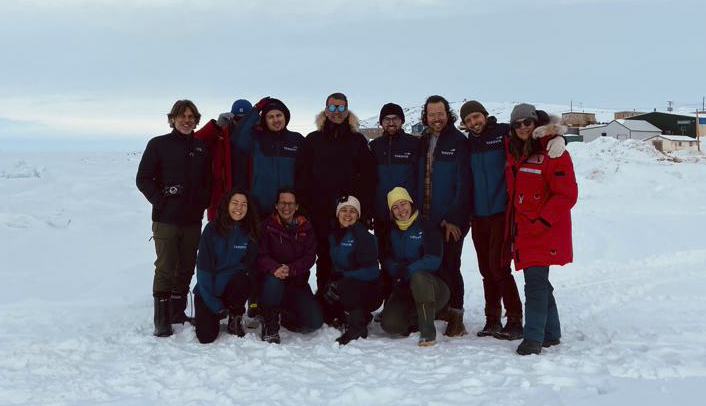
Students' projects
Gabriel Lapointe
My master's thesis is about the design of a probe that can measure the concentration of nitrate and nutrients in the brine pockets of sea ice. The QikIce mission was a great opportunity for me to test the concept of my instrument and the first design of its prototype.
First, a really important part of the probe to test was the heating probe part, which was challenging to design because we had a limited power supply in the field and we were concerned that the heat wouldn't be enough to get deep enough and keep the water liquid through the pumping system. This part was tested by simply placing the endoscope section in the ice and waiting for the ice to melt as the water was pumped up. After a few problems with the control of the probing system, caused by an overload in the microcontroller, the system was able to get through most of the sea ice in a few hours, pumping brine water for each depth. Even though it took a considerable amount of time to penetrate the ice and only a small number of sites were explored, I would consider this part a success and only a few modifications would have to be made to upgrade the next prototype, such as better control of the heating and pumping system.
Second, the part of the in-situ analysis didn't work as intended. The system was supposed to pump the brine water into a liquid optical guide through which a UV light source would pass and come out again to analyze the absorption spectrum and measure the concentration of nutrients. Unfortunately, the UV light source we brought malfunctioned and wasn't usable for the entire mission. So instead, we collected many more samples to bring back to Quebec for analysis; when the problem is fixed with the UV lamp, we will compare the samples we collected with two analyses approach, the traditional method with the autoanalyzer and with this newly approach for field measurements.
Finally, the collection of brine samples was measured by measuring the salinity of each sample. This part is the most exciting right now because it showed better results than expected. Not only was the instrument able to sample a salinity profile through the ice, but it was able to collect a non-negligible amount of water at a salinity point of over 90 ppt (the sea is at 35 ppt), and was much more concentrated in brine than the samples in sackholes or by coring. The sackhole technique, which involves drilling a hole in the sea ice without reaching the bottom of the ice and waiting for the brine to flow in and fill the hole, was also explored a bit for collecting brine. Since this is not the most popular protocol for brine sampling, it was really useful to test the limits of this protocol. For example, by drilling holes of different sizes, we found that the smaller the diameter, the saltier the collected brines are and the faster the hole fills. In conclusion, the mission was for the most part successful for my master and for the advancement of my project.
Béatrice Lessard-Hamel
Gaining microscopic insight into sea-ice’s internal structure and biology has traditionally been limited to destructive and extrusive ice-core sampling methods. To make progress in the exploration of sea-ice micro-habitats, and in the study of sea-ice microorganisms with minimal disturbance, we are developing an innovative in-situ microscopic imaging system to observe the living microorganisms directly within sea-ice. I developed a prototype and tested it in the lab and my participation in the Qikice mission gave me the chance to test it on the field. The first tests were a success, and I achieved my goal of validating my prototype. With these results, we can demonstrate the potential for this new in-situ microscopic imaging system to revolutionize the way we study sea-ice and provide a deeper understanding of its complex microstructures and living microorganisms.
Christophe Perron
The inherent optical properties (IOPs) of Arctic sea ice play a fundamental role in our understanding of Arctic marine climate and ecosystems. Firstly, these IOPs are used to calculate the transformation of solar radiation into heat that melts sea ice. Secondly, they are used to calculate the quantity of light available for photosynthetic organisms in and under the sea ice.
However, it is very difficult to measure these IOPs without destroying the ice that we are trying to look at, which is why these properties have been studied very little. Simply taking a sample fractures the ice matrix, drains its liquid content and exposes the sample to melting caused by the sun. After which, all optical measurements on the sample are no longer accurate.
To solve this sample destructiveness issue, we have developed and tested three techniques for measuring the IOPs of sea ice directly in the medium. A spectral reflectance probe makes it possible to find the IOPs of the surface of the ice without even drilling a hole in it. Then, by drilling a small hole, 2 other endoscopic instruments called a radiance camera and a diffuse reflectance probe allow us to measure deeper inside the ice column while keeping a small footprint. These 3 techniques developed in our laboratory are unique in their kind and promise to improve our understanding of Arctic sea ice.
Raphaël Larouche
Light availability for micro-algae at the bottommost part of the ice pack is controlled by ice’s microstructure and optical properties. This spring mission to Qikiqtarjuaq was an opportunity to assess the spatial variability of sea ice optical properties around the island. In that regard, we deployed a new kind of optical sensor that measures light coming from all the directions. This gives the tri-dimensional structure of the light that gets transmitted at a certain point in sea ice. It was possible by transforming a commercial 360-degrees camera with a small form factor into a scientific radiometer. During the mission, we successfully acquired the angular distribution of the light in absolute units at different depths inside the top layer of snow, the ice and few centimeters in the ocean below, giving an unprecedent amount of information for all the scientific community.
Bastian Raulier
Project title : Radiative transfer in sea ice (Director : Marcel Babin, Co-director : Daniel Côté)
Sea ice is a very complex environment. Indeed, we can easily imagine that it depends on the state of the sea in which the ice pack was formed, on the presence of waves, particles, dissolved matter, and on the temperature. Then, during the winter, the ice is transformed, and snow accumulates on top of it. Then in spring, it is this icepack, with its complex history that defines the amount of light available for photosynthetic organisms. The Arctic being vast and not easily accessible, it is rather difficult to access each of the ice cubes found there and inquire about its past. It is therefore necessary to use models that simplify the problem and allow a simpler representation of the complexity of the sea ice.
To develop this simpler yet useful sea ice model, we conducted a thorough study of the ice pack in Qikiqtarjuaq during the spring of 2023. Our study focused on gathering information regarding the reflectance, transmittance, internal radiance, as well as the factors influencing them, such as the scattering and absorption coefficients. By incorporating this data into a numerical model of sea ice, we will be able to selectively prioritize the most significant ice layers and their primary variables. The extensive dataset obtained during the QikIce expedition, utilizing various endoscopes, will drive numerical simulations in the upcoming year and contribute to the advancement of a more accurate representation of sea ice in large-scale models.
Bastian Raulier's profile (Takuvik)
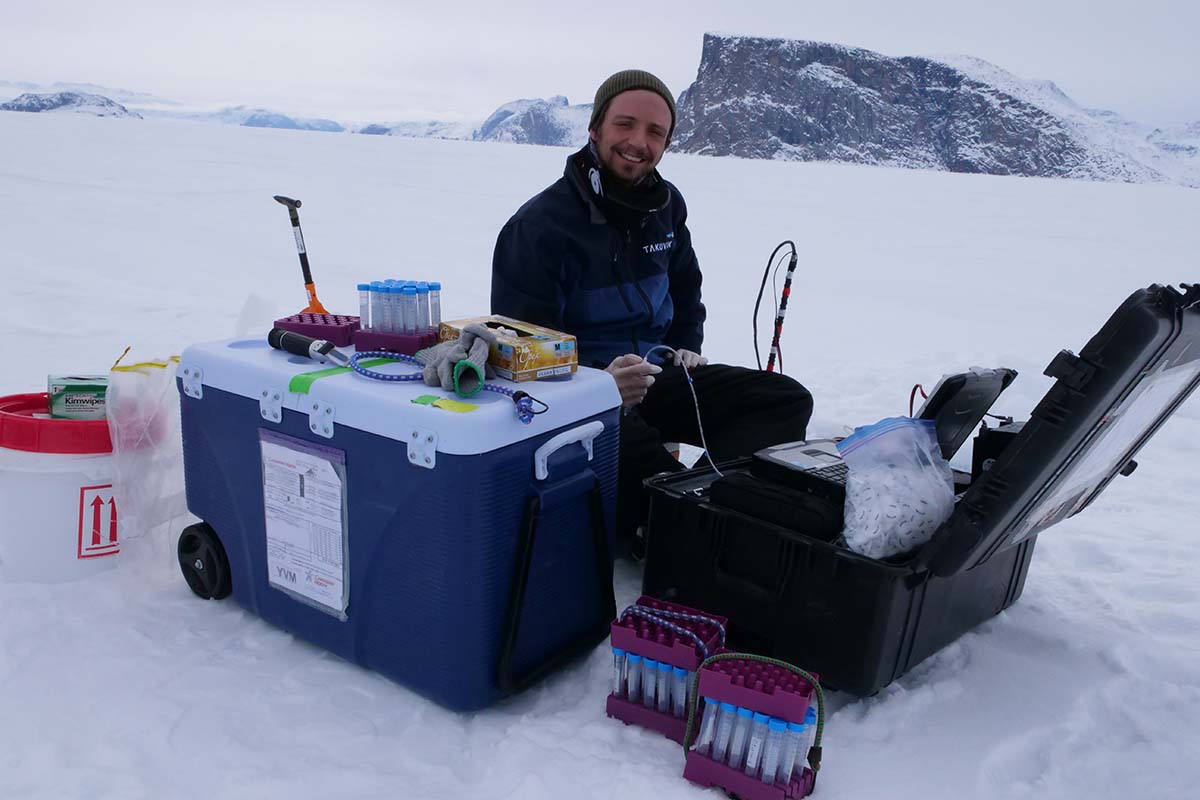
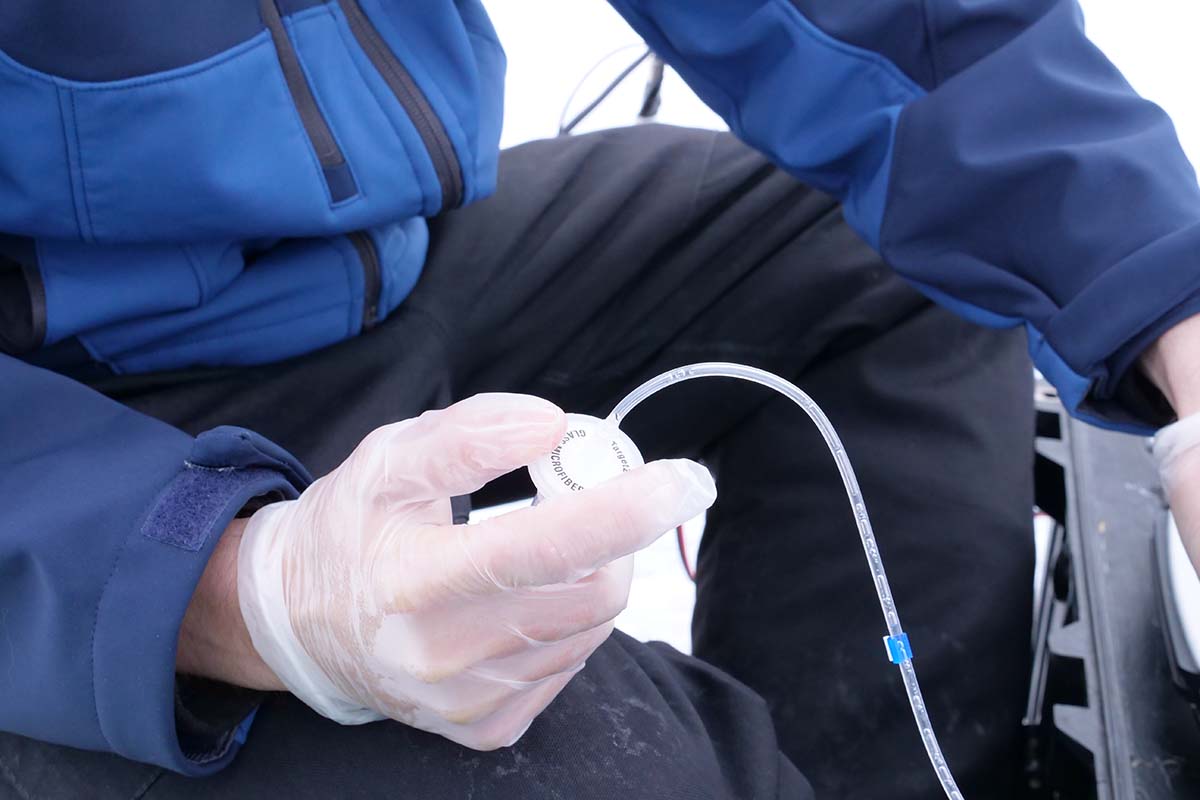
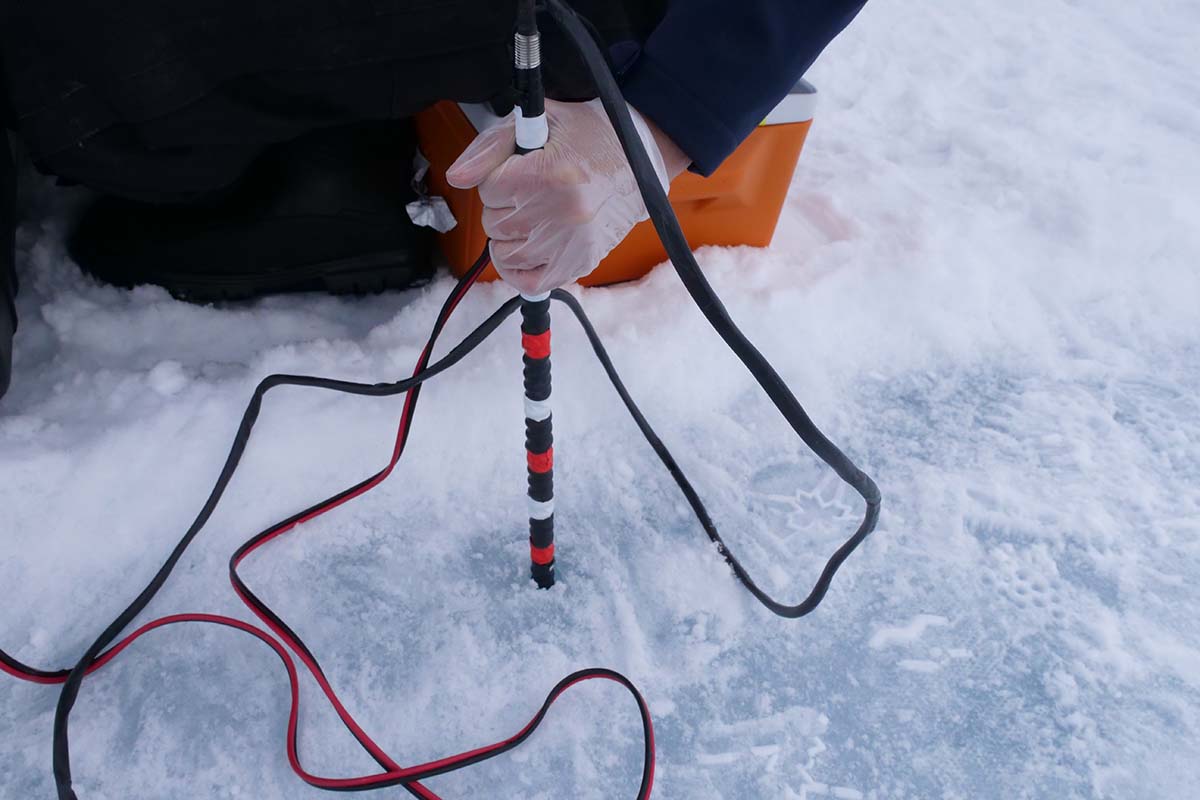
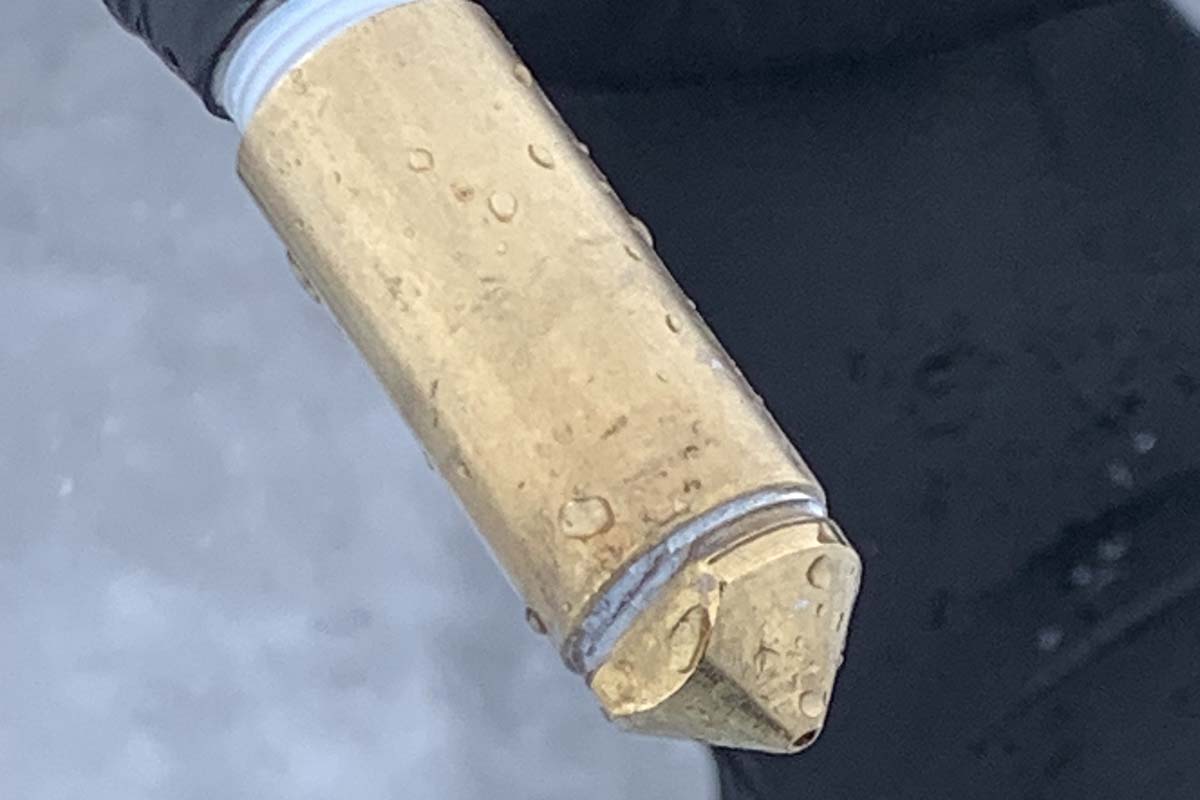


 To address this challenge, the QikIce 2023 mission, which took place near Qikiqtarjuaq, Nunavut, from 19 April to 3 May and led by
To address this challenge, the QikIce 2023 mission, which took place near Qikiqtarjuaq, Nunavut, from 19 April to 3 May and led by 
